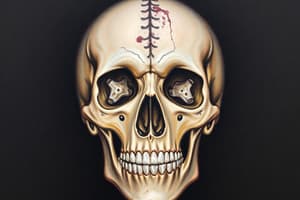Podcast
Questions and Answers
What anatomical and physiological differences in the pediatric population modify the outcomes of Traumatic Brain Injury (TBI) in these patients?
What anatomical and physiological differences in the pediatric population modify the outcomes of Traumatic Brain Injury (TBI) in these patients?
- Smaller head size and reduced oxygen consumption
- Ongoing myelination and synaptogenesis (correct)
- Decreased brain content and slower synapse development
- Higher center of gravity and lower cerebral blood flow
What is a major direct cause that falls under educational and vocational considerations in TBI?
What is a major direct cause that falls under educational and vocational considerations in TBI?
- Physical assistance and classroom adaptations (correct)
- Genetic predisposition
- Inadequate social support
- Low socioeconomic status
Which demographic group has the highest percentage of injuries attributed to falls according to the text?
Which demographic group has the highest percentage of injuries attributed to falls according to the text?
- Abuse/Assault
- Sports/Recreational Activities
- Gunshot wounds
- Motor vehicle accidents (correct)
What type of injury is characterized by an external, mechanical force impacting the head?
What type of injury is characterized by an external, mechanical force impacting the head?
What kind of functional outcomes can result from a Traumatic Brain Injury according to the text?
What kind of functional outcomes can result from a Traumatic Brain Injury according to the text?
Which factor contributes to greater oxygen consumption in pediatric TBI patients compared to adults?
Which factor contributes to greater oxygen consumption in pediatric TBI patients compared to adults?
Which scale is used to assess the severity of traumatic brain injury?
Which scale is used to assess the severity of traumatic brain injury?
Which type of cerebral palsy has a poorer prognosis in severe traumatic brain injury cases?
Which type of cerebral palsy has a poorer prognosis in severe traumatic brain injury cases?
What is a possible mechanism responsible for primitive infantile reflex in infants?
What is a possible mechanism responsible for primitive infantile reflex in infants?
Which medical complication is commonly associated with traumatic brain injury?
Which medical complication is commonly associated with traumatic brain injury?
In cerebral palsy, which type is characterized by involuntary muscle movements?
In cerebral palsy, which type is characterized by involuntary muscle movements?
What is the main purpose of the Glasgow Coma Scale in pediatric TBI cases?
What is the main purpose of the Glasgow Coma Scale in pediatric TBI cases?
Which neurologic abnormality is typically associated with diffuse axonal injury?
Which neurologic abnormality is typically associated with diffuse axonal injury?
In pediatric traumatic brain injuries, what leads to bulging of fontanels and separation of sutures?
In pediatric traumatic brain injuries, what leads to bulging of fontanels and separation of sutures?
What is the major mechanism produced by acceleration-deceleration injuries in traumatic brain injury?
What is the major mechanism produced by acceleration-deceleration injuries in traumatic brain injury?
In pediatric patients, what can edema with increased intracranial pressure lead to?
In pediatric patients, what can edema with increased intracranial pressure lead to?
What type of injury is characterized by injured neurons releasing excitatory neurotransmitters and oxygen-free radicals?
What type of injury is characterized by injured neurons releasing excitatory neurotransmitters and oxygen-free radicals?
Which neural condition is typically associated with separation of sutures and brain shift post-TBI in pediatric patients?
Which neural condition is typically associated with separation of sutures and brain shift post-TBI in pediatric patients?
Flashcards are hidden until you start studying



